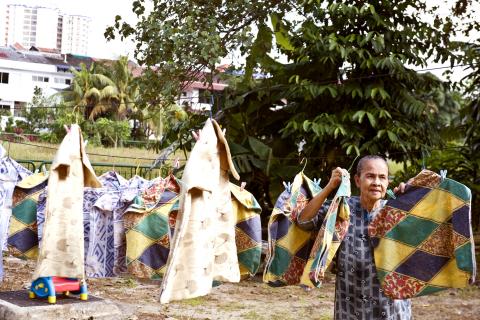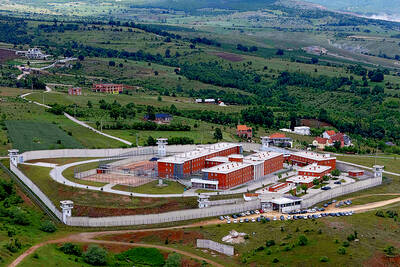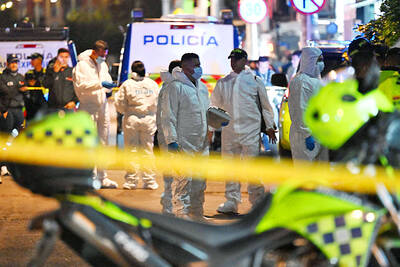Quietly tucked away in a corner surrounded by high-rise apartments and rows of bungalows is a rustic village where the old Singapore still survives.
Dogs and cats run freely and chickens cluck noisily as children play around colorful, zinc-roofed houses made of wood and cement, undisturbed by the din of cars zipping by on an expressway just a few meters away.
Welcome to Kampong Lorong Buangkok, the last surviving village on the Singapore mainland.

Photo: AFP
Its days are numbered, but until development forces residents to move, the village gives visitors a glimpse of what life was like in the 1950s before Singapore became one of Asia’s most modern and wealthiest cities.
Occupying a land area the size of three soccer pitches in the northeastern suburbs, the kampong (“village” in the Malay language) has 28 houses scattered haphazardly with a total of about 50 residents.
With unpaved streets, large backyard gardens, grassy patches and occasional banana plants, the cluster is an anachronism in a city-state crammed with office towers, high-rise apartment blocks and shopping malls.
For residents, the village provides relief at the end of each working day, a quiet oasis where neighbors still know each other intimately, quite unlike the anonymity of city living.
“I have a deep attachment to my neighbors,” said Sng Mui Hong, a 57-year-old spinster who rents out houses in the village for S$6.50 to S$30 (US$5 to US$23) a month.
Most of Singapore’s 5 million residents live in government-built apartment buildings and private condominiums.
“After all they grew up with me, and some of the grandmothers and grandfathers here have watched me grow up,” said Sng, who currently lives with a nephew and niece, three dogs and several pet birds.
Her family moved into the plot of land in 1956, when Singapore was still under British colonial rule. Electricity and running water came into the village in 1962, a period when the country was in political transition.
Singapore, a largely ethnic Chinese island, became part of the Federation of Malaysia in 1963, but was expelled two years later as Kuala Lumpur pursued policies favorable to the Malay majority.
In modern-day Kampong Lorong Buangkok, racial harmony comes naturally for the Chinese and Malay families whose houses are about 5m apart.
“They are like my own parents because we are from the same village. So I don’t care if they are Malay or Chinese,” Sng said of her older neighbors.
And while the village is by Singapore standards far from supermarkets, schools and bus and train stops, residents rarely mind as there are perks to village life that cannot be found elsewhere.
Some even own cars, a luxury in Singapore.
Makeup artist Jamil Kamsah, who has lived in Kampong Lorong Buangkok since 1967, enjoys the amicable nature of the village folk.
“People here are very friendly, motherly and polite, and it is easy for me to make friends with them,” the 55-year-old said. “I don’t scold animals and I talk to plants.”
In his free time, Jamil tends to his garden and touches up the exterior of his house, welcoming visitors with a ready smile.
In land-scarce Singapore, where many older buildings and residential areas have been converted to more modern housing or commercial use, Kampong Lorong Buangkok faces an uncertain future. Sng hopes the village can be preserved to educate future generations about the past and show them how their forefathers lived.
“Not everybody started off wealthy, many grandfathers built their lives from scratch,” she said
Some city schools take their young students on excursion trips to Kampong Lorong Buangkok to learn about village life.
“Some children mistook the chickens for birds,” Kamsah said.
The village’s days are numbered, and the residents know it.
Singapore’s land-use planning agency, the Urban Redevelopment Authority (URA), said there are plans to redevelop Kampong Lorong Buangkok, but gave no time frame.
“The kampong at Lorong Buangkok and its surrounding land is planned to be comprehensively developed to provide future housing and other neighborhood facilities supported by a road network,” a URA spokesperson said.
Sng, however, does not feel sad even if her village has to go one day.
“Nothing lasts forever,” she said with a shrug.

By 2027, Denmark would relocate its foreign convicts to a prison in Kosovo under a 200-million-euro (US$228.6 million) agreement that has raised concerns among non-governmental organizations (NGOs) and residents, but which could serve as a model for the rest of the EU. The agreement, reached in 2022 and ratified by Kosovar lawmakers last year, provides for the reception of up to 300 foreign prisoners sentenced in Denmark. They must not have been convicted of terrorism or war crimes, or have a mental condition or terminal disease. Once their sentence is completed in Kosovan, they would be deported to their home country. In

Brazil, the world’s largest Roman Catholic country, saw its Catholic population decline further in 2022, while evangelical Christians and those with no religion continued to rise, census data released on Friday by the Brazilian Institute of Geography and Statistics (IBGE) showed. The census indicated that Brazil had 100.2 million Roman Catholics in 2022, accounting for 56.7 percent of the population, down from 65.1 percent or 105.4 million recorded in the 2010 census. Meanwhile, the share of evangelical Christians rose to 26.9 percent last year, up from 21.6 percent in 2010, adding 12 million followers to reach 47.4 million — the highest figure

LOST CONTACT: The mission carried payloads from Japan, the US and Taiwan’s National Central University, including a deep space radiation probe, ispace said Japanese company ispace said its uncrewed moon lander likely crashed onto the moon’s surface during its lunar touchdown attempt yesterday, marking another failure two years after its unsuccessful inaugural mission. Tokyo-based ispace had hoped to join US firms Intuitive Machines and Firefly Aerospace as companies that have accomplished commercial landings amid a global race for the moon, which includes state-run missions from China and India. A successful mission would have made ispace the first company outside the US to achieve a moon landing. Resilience, ispace’s second lunar lander, could not decelerate fast enough as it approached the moon, and the company has

‘THE RED LINE’: Colombian President Gustavo Petro promised a thorough probe into the attack on the senator, who had announced his presidential bid in March Colombian Senator Miguel Uribe Turbay, a possible candidate in the country’s presidential election next year, was shot and wounded at a campaign rally in Bogota on Saturday, authorities said. His conservative Democratic Center party released a statement calling it “an unacceptable act of violence.” The attack took place in a park in the Fontibon neighborhood when armed assailants shot him from behind, said the right-wing Democratic Center, which was the party of former Colombian president Alvaro Uribe. The men are not related. Images circulating on social media showed Uribe Turbay, 39, covered in blood being held by several people. The Santa Fe Foundation